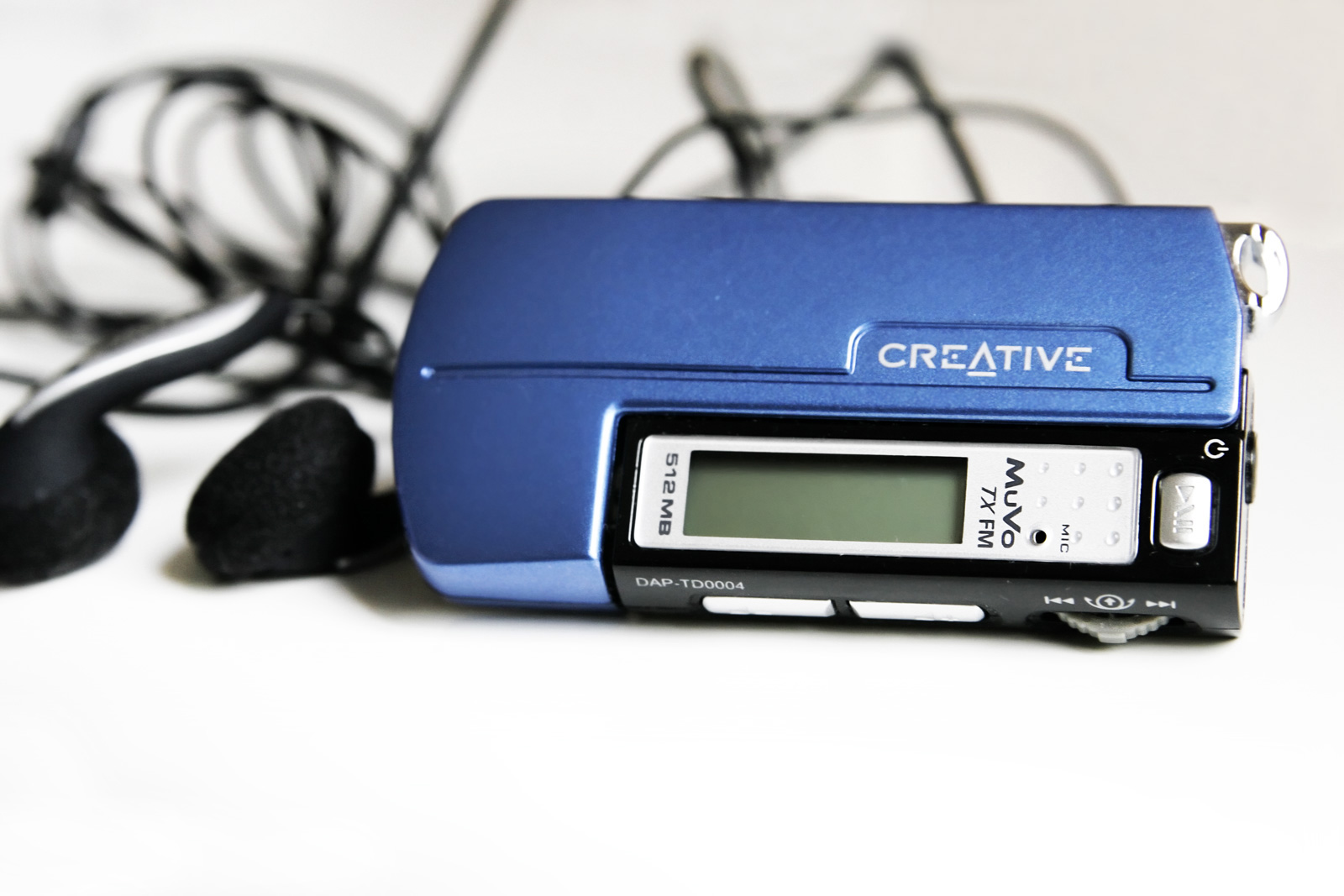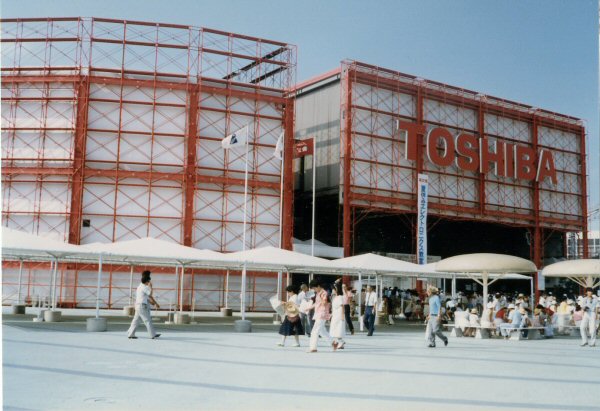|
Gigabeat
The Gigabeat was a line of digital media players by Toshiba. Gigabeat The Gigabeat was first called the MobilPhile and later renamed to Gigabeat. It contained a monochrome LCD with blue backlighting, and a 5 GB removable PCMCIA hard drive. Its case was made of aluminum, and battery life is specified at 18 hours. It required music to be converted using the Toshiba Audio Application to an encrypted format. It has a circular D-pad surrounding a smaller circular play/pause button, 2 menu buttons, side-mounted volume up/down buttons and a lock switch. Gigabeat G The Gigabeat G was first introduced during the Japanese WPC Expo in September 2003. The hard drive player features capacities from 5 GB to 40 GB, support for MP3, WMA and WAV sound files, USB 2.0, and integration with Windows Media Player. The device has a 160x86-pixel monochromic screen with blue backlighting. Battery life is specified at 11 hours. It is only available in Japan. The Gigabeat G was updated a ... [...More Info...] [...Related Items...] OR: [Wikipedia] [Google] [Baidu] |
Portable Media Player
A portable media player (PMP) or digital audio player (DAP) is a portable consumer electronics device capable of storing and playing digital media such as audio, images, and video files. Normally they refer to small, Electric battery, battery-powered devices utilising flash memory or a Hard disk drive, hard disk for storing various media Computer file, files. MP3 players has been a popular alternative name used for such devices, even if they also support other file formats and media types other than MP3 (for example Advanced Audio Coding, AAC, FLAC, Windows Media Audio, WMA). Generally speaking, PMPs are equipped with a 3.5 mm headphone jack which can be used for headphones or to connect to a boombox, home audio system, or connect to car audio and home High fidelity, stereos wired or via a wireless connection such as Bluetooth, and some may include radio tuners, voice recording and other features. In contrast, analogue portable audio players play music from non-digital m ... [...More Info...] [...Related Items...] OR: [Wikipedia] [Google] [Baidu] |
Zune
Zune was a brand of digital media products and services that was marketed by Microsoft from November 2006 until it was discontinued in June 2012. Zune consisted of a line of portable media players, a music subscription service known as Zune Music Pass plus Zune Marketplace for music, TV and movies, streaming services for the Xbox 360 game console, and the Zune Software, Zune software media player for Microsoft Windows, Windows PCs which also acted as desktop sync software for Windows Phone. The Zune started and revolved around its line of portable media players (PMP) created in cooperation with Toshiba. Microsoft aimed to challenge and beat Apple Inc., Apple, whose iPod line held an enormous market share. Three hard disk players ranging from 30 GB to 120 GB were released, alongside six flash memory, flash players. However, its overall market share in the U.S. remained low, well below Apple and also lagging the SanDisk Sansa and Creative Zen. Microsoft discontinued all Zu ... [...More Info...] [...Related Items...] OR: [Wikipedia] [Google] [Baidu] |
Rockbox
Rockbox is a free and open-source software replacement for the OEM firmware in various forms of digital audio players (DAPs) with an original kernel. It offers an alternative to the player's operating system, in many cases without removing the original firmware, which provides a plug-in architecture for adding various enhancements and functions. Enhancements include personal digital assistant (PDA) functions, applications, utilities, and games. Rockbox can also retrofit video playback functions on players first released in mid-2000. Rockbox includes a voice-driven user-interface suitable for operation by visually impaired users. Rockbox runs on a wide variety of devices with very different hardware abilities: from early Archos players with 1-bit character cell-based displays, to modern players with high resolution color displays, digital optical audio hardware and advanced recording abilities. History The Rockbox project was founded by the three Swedish developers Linus Fel ... [...More Info...] [...Related Items...] OR: [Wikipedia] [Google] [Baidu] |
Windows Media Audio
Windows Media Audio (WMA) is a series of audio codecs and their corresponding audio coding formats developed by Microsoft. It is a proprietary technology that forms part of the Windows Media framework. Audio encoded in WMA is stored in a digital container format called Advanced Systems Format (ASF). WMA consists of four distinct codecs. The original WMA codec, known simply as ''WMA'', was conceived as a competitor to the popular MP3 and RealAudio codecs. ''WMA Pro'', a newer and more advanced codec, supports multichannel and high-resolution audio. A lossless codec, ''WMA Lossless'', compresses audio data without loss of audio fidelity (the regular WMA format is lossy). ''WMA Voice'', targeted at voice content, applies compression using a range of low bit rates. Development history The first WMA codec was based on earlier work by Henrique Malvar and his team which was transferred to the Windows Media team at Microsoft. Malvar was a senior researcher and manager of th ... [...More Info...] [...Related Items...] OR: [Wikipedia] [Google] [Baidu] |
Toshiba
is a Japanese multinational electronics company headquartered in Minato, Tokyo. Its diversified products and services include power, industrial and social infrastructure systems, elevators and escalators, electronic components, semiconductors, hard disk drives, printers, batteries, lighting, as well as IT solutions such as quantum cryptography. It was formerly also one of the biggest manufacturers of personal computers, consumer electronics, home appliances, and medical equipment. The Toshiba name is derived from its former name, Tokyo Shibaura Denki K.K. which in turn was a 1939 merger between Shibaura Seisaku-sho (founded in 1875) and Tokyo Denki (founded in 1890). The company name was officially changed to Toshiba Corporation in 1978. A technology company with a long history and sprawling businesses, Toshiba is a household name in Japan and has long been viewed as a symbol of the country's technological prowess post-World War II. As a semiconductor company and the i ... [...More Info...] [...Related Items...] OR: [Wikipedia] [Google] [Baidu] |
Audio Video Interleave
Audio Video Interleave (also Audio Video Interleaved and known by its initials and filename extension AVI, usually pronounced ) is a proprietary multimedia container format and Windows standard introduced by Microsoft in November 1992 as part of its Video for Windows software. AVI files can contain both audio and video data in an uncompressed file container that allows synchronous audio-with-video playback. Like the DVD video format, AVI files support multiple streaming audio and video, although these features are seldom used. Codecs popularly used for AVI include DivX and Xvid, although many other codecs can also be contained in an AVI file. Many AVI files use the file format extensions developed by the Matrox OpenDML group in February 1996. These files are supported by Microsoft, and are unofficially called AVI 2.0. In 2010 the US government's National Archives and Records Administration defined AVI as the official wrapper for preserving digital video. History ... [...More Info...] [...Related Items...] OR: [Wikipedia] [Google] [Baidu] |
1-bit DAC
A 1-bit DAC (sometimes called Bitstream converter by Philips) is a consumer electronics marketing term describing an oversampling digital-to-analog converter (DAC) that uses a digital noise shaping delta-sigma modulator operating at many multiples of the sampling frequency that outputs to an ''actual'' 1-bit DAC (which could be fully differential to minimize crosstalk). The combination can have high signal-to-noise and hence an equivalent effective number of bits as a DAC with a larger number of bits (usually 16-20). The advantages of this type of converter are high linearity combined with low cost, owed to the fact that most of the processing takes place in the digital domain, which helps relax the requirements for the subsequent analog low-pass filter (for anti-aliasing image frequencies and suppressing high-frequency noise-shaping noise). For these reasons, this design is very popular in digital consumer electronics (CD/DVD players, set-top boxes and the like). While single-bi ... [...More Info...] [...Related Items...] OR: [Wikipedia] [Google] [Baidu] |
Toshiba Gigabeat U
is a Japanese multinational electronics company headquartered in Minato, Tokyo. Its diversified products and services include power, industrial and social infrastructure systems, elevators and escalators, electronic components, semiconductors, hard disk drives, printers, batteries, lighting, as well as IT solutions such as quantum cryptography. It was formerly also one of the biggest manufacturers of personal computers, consumer electronics, home appliances, and medical equipment. The Toshiba name is derived from its former name, Tokyo Shibaura Denki K.K. which in turn was a 1939 merger between Shibaura Seisaku-sho (founded in 1875) and Tokyo Denki (founded in 1890). The company name was officially changed to Toshiba Corporation in 1978. A technology company with a long history and sprawling businesses, Toshiba is a household name in Japan and has long been viewed as a symbol of the country's technological prowess post-World War II. As a semiconductor company and the invento ... [...More Info...] [...Related Items...] OR: [Wikipedia] [Google] [Baidu] |
Widescreen
Widescreen images are displayed within a set of aspect ratio (image), aspect ratios (relationship of image width to height) used in film, television and computer screens. In film, a widescreen film is any film image with a width-to-height aspect ratio greater than 4:3 (1.33:1). For TV, the original screen ratio for broadcasts was in 4:3 (1.33:1). Largely between the 1990s and early 2000s, at varying paces in different countries, 16:9 (e.g. 1920×1080p 60p) widescreen displays came into increasingly common use by high-definition video, high definitions. With computer displays, aspect ratios other than 4:3 (e.g. 1920×1440) are also referred to as "widescreen". Widescreen computer displays were previously made in a 16:10 aspect ratio (e.g. 1920×1200), but nowadays they are 16:9 (e.g. 1920×1080, 2560×1440, 3840×2160). Film History Widescreen was first used for ''The Corbett-Fitzsimmons Fight'' (1897). This was not only the longest film that had been released to date at 10 ... [...More Info...] [...Related Items...] OR: [Wikipedia] [Google] [Baidu] |
1seg
is a mobile terrestrial digital audio/video and data broadcasting service in Japan, Argentina, Brazil, Chile, Uruguay, Paraguay, Peru and the Philippines. Service began experimentally during 2005 and commercially on April 1, 2006. It is designed as a component of ISDB-T, the terrestrial digital broadcast system used in those countries, as each channel is divided into 13 segments, with a further segment separating it from the next channel; an HDTV broadcast signal occupies 12 segments, leaving the remaining (13th) segment for mobile receivers, hence the name, "1seg" or "One Seg". Its use in Brazil was established in late 2007 (starting in just a few cities), with a slight difference from the Japanese counterpart: it is broadcast under a 30 fps transmission setting (Japanese broadcasts are under the 15 fps transmission setting). Technical information The ISDB-T system uses the UHF band at frequencies between 470 and 770 MHz (806 MHz in Brazil), giving a total ban ... [...More Info...] [...Related Items...] OR: [Wikipedia] [Google] [Baidu] |
USB On-The-Go
USB On-The-Go (USB OTG or just OTG) is a specification first used in late 2001 that allows USB devices, such as tablets or smartphones, to also act as a host, allowing other USB devices, such as USB flash drives, digital cameras, mice or keyboards, to be attached to them. Use of USB OTG allows devices to switch back and forth between the roles of host and device. For example, a smartphone may read from removable media as the host device, but present itself as a USB Mass Storage Device when connected to a host computer. USB OTG introduces the concept of a device performing both Host and Peripheral roles whenever two USB devices are connected and one of them is a USB OTG device, they establish a communication link. The device controlling the link is called the Host, while the other is called the Peripheral. USB OTG defines two roles for devices: OTG A-device and OTG B-device, specifying which side supplies power to the link, and which initially is the host. The OTG A-device is ... [...More Info...] [...Related Items...] OR: [Wikipedia] [Google] [Baidu] |





